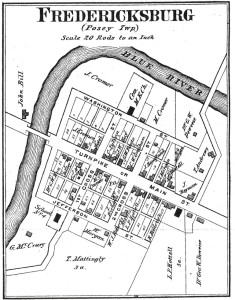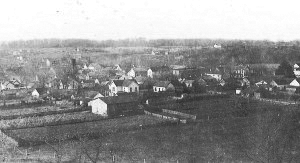Washington County’s 1st Settlement
The first pioneer settlement, in what would become Washington County, formed around a squatter, who migrated here somewhere between 1800 and 1805. He built a little cabin on poles, in Section 15 of Washington Township, on the forks of Blue River, where there was a salt lick and began a mining operation. In the pioneer era, salt was very valuable, primarily used as a preservative, it was essential to survival on the frontier of civilization.
This squatter’s name was, Frederick Royse, he had been born, circa 1750, in Bedford County, Pennsylvania and he served some time with the Pennsylvania Rangers during the Revolutionary War. However by 1778, he had migrated south and married Sarah DeWitt, in Hampshire County, Virginia. Here the couple had their first two children, before migrating to Fayette County, Kentucky, in 1783. They stayed in Kentucky for 16 years and had 8 more children, before crossing the Ohio River into Clark’s Grant, in 1799.
By the early 1800’s, Frederick had ventured into our county and set up his mining operation, near one of the Delaware Indian villages of Chief Old Ox. The Indians and Mr. Royse were said to have had an amicable relationship and conducted considerable trading with one another. Frederick had bought and sold a considerable amount of land in Clark County, so it is not clear when his family joined him at the salt lick, but one speculation is that Frederick came between 1800 and 1803, and his family joined him in 1805.
Frederick got his first pioneer neighbor, Dr. Simeon Lamb, the same year the lands of the future Washington County were surveyed by the government, in 1806. Besides doctoring, Simeon opened a crude little general store, at the lick, with supplies he would bring up from Louisville and Clarksville. When our county’s land was made available to purchase from the U.S. Government, in 1807, it didn’t take long for settlers to migrate to the area where they could buy salt, along with goods from Dr. Lamb’s store and trade with the Indians. The salt lick quickly became known as, Royse’s Lick, for Frederick and the little settlement that began to spring up around him, as the Royse’s Lick settlement.
 This area became the unofficial county seat and was the focal point for most every settler who came to the area prior to 1814, when Salem was officially selected as the seat of justice, for the newly established Washington County. But by this time, Frederick had moved on. He sold his interests in the salt mine, in 1812, to early settlers, Moses Hoggatt and Judge Godlove Kemp. When Frederick was mining the lick, he was able to produce one bushel of salt a day, which sold for a staggering $12, which in today’s money would be, $230.76! After Kemp and Hoggatt bought the mine, they increased production to 3 bushels a day. In 1816, when Indiana was admitted into the Union, any lands upon which salt water or other valuable minerals were located were claimed by the state, so the two men lost their investment. The state continued to manufacture salt at Royse’s Lick into the 1820’s, when the vein apparently dried up.
This area became the unofficial county seat and was the focal point for most every settler who came to the area prior to 1814, when Salem was officially selected as the seat of justice, for the newly established Washington County. But by this time, Frederick had moved on. He sold his interests in the salt mine, in 1812, to early settlers, Moses Hoggatt and Judge Godlove Kemp. When Frederick was mining the lick, he was able to produce one bushel of salt a day, which sold for a staggering $12, which in today’s money would be, $230.76! After Kemp and Hoggatt bought the mine, they increased production to 3 bushels a day. In 1816, when Indiana was admitted into the Union, any lands upon which salt water or other valuable minerals were located were claimed by the state, so the two men lost their investment. The state continued to manufacture salt at Royse’s Lick into the 1820’s, when the vein apparently dried up.
 Early view of the Town of Fredericksburg, IndianaFrederick Royse and his family moved southwest, down Blue River to Section 9, in Posey Township, after selling his interests in the salt mine and purchased 1500 acres. Here in September of 1815, he had 59 lots laid out by the county surveyor, William Lindley Jr., for the town of Fredericksburg, named in Royse’s honor. This area was about a half mile north of the present town site and soon had around 20 families settled there, but due to repeated flooding and the main thoroughfare being just downstream, it was agreed to relocate the town. Around 1820, Frederick & Sarah Royse moved about 2 miles east and settled in Sections 11 & 12 of Posey Township. Here Frederick and Sarah would spend their remaining days, Frederick passed away in the latter part of 1825 and his wife Sarah died just a couple of years later. Both were buried on their farm.
Early view of the Town of Fredericksburg, IndianaFrederick Royse and his family moved southwest, down Blue River to Section 9, in Posey Township, after selling his interests in the salt mine and purchased 1500 acres. Here in September of 1815, he had 59 lots laid out by the county surveyor, William Lindley Jr., for the town of Fredericksburg, named in Royse’s honor. This area was about a half mile north of the present town site and soon had around 20 families settled there, but due to repeated flooding and the main thoroughfare being just downstream, it was agreed to relocate the town. Around 1820, Frederick & Sarah Royse moved about 2 miles east and settled in Sections 11 & 12 of Posey Township. Here Frederick and Sarah would spend their remaining days, Frederick passed away in the latter part of 1825 and his wife Sarah died just a couple of years later. Both were buried on their farm.
In 1969, descendants of Frederick & Sarah, had a historical marker placed at the west end of the Fredericksburg Bridge to honor their pioneer ancestors. In 1971, another historical marker was erected, by their descendants at Horner’s Chapel, listing Frederick’s Revolutionary service and the service of all of his sons and son-in-laws in the War of 1812.
The Frederick Royse family was instrumental in the founding of Washington County, drawing many other pioneers to the area and several of their descendants are still living here today, over 200 years after their arrival.


